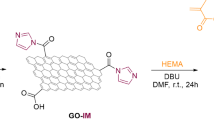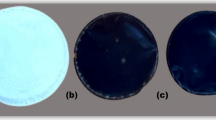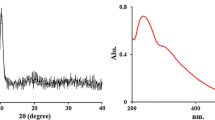Abstract
Redox-modulating ceria nanoparticles can impart bioactivity to biodegradable polymers for tissue regeneration but are limited by poor dispersion in the polymer matrix. Toward the development of biodegradable multifunctional biomaterials, cerium oxide (ceria)-decorated graphene-based hybrid nanoparticles were used as nanofillers in a polyurethane matrix. The polyurethane was synthesized using olive oil-based polyol to impart degradability to the composite. Hybrid nanoparticles consisting of ceria anchored on graphene sheets were synthesized by the hydrothermal process. X-ray diffraction, transmission electron microscopy, and X-ray photoelectron spectroscopy confirmed the anchoring of ceria nanoparticles on the graphene sheets. Polyurethane composites were prepared by in situ polymerization. Hybrid nanoparticle-infused composites showed uniform dispersion, unlike the agglomerated particles in ceria-infused composites. The hybrid nanocomposite showed improved mechanical properties compared to the ceria nanocomposite. The nanocomposite was non-toxic to pre-osteoblasts. The polyurethane demonstrated enhanced radical-scavenging potential after adding the hybrid nanoparticles in contrast to a neat polymer or graphene oxide-infused composite. The cells exhibited improved osteogenic differentiation on the hybrid composites than on the neat polyurethane or the GO-composite. Thus, the graphene and ceria in the hybrid particles synergistically render multifunctional properties to polyurethanes for potential application in bone tissue regeneration.
Graphical Abstract









Similar content being viewed by others
Data Availability
Data will be made available on reasonable request.
References
Chan BP, KW Leong (2008) Scaffolding in tissue engineering: general approaches and tissue-specific considerations. Eur Spine J 17(Suppl 4):467
Nikolova MP, Chavali MS (2019) Recent advances in biomaterials for 3D scaffolds. Rev Bioact Mater 4:271
Guo ZC, Poot AA, Grijpma DW (2021) Advanced polymer-based composites and structures for biomedical applications. Eur Polym J 149:110388
Fathi-Achachelouei M, Knopf-Marques H, da Silva CER et al (2019) Use of nanoparticles in tissue Engineering and Regenerative Medicine. Front Bioeng Biotech 7:113
Boccaccini AR, Erol M, Stark WJ, Mohn D, Hong ZK, JF Mano (2010) Polymer/bioactive glass nanocomposites for biomedical applications: a review. Compos Sci Technol 70(13):1764
Kumar S, Chatterjee K (2015) Strontium eluting graphene hybrid nanoparticles augment osteogenesis in a 3D tissue scaffold Nanoscale 7 (5): 2023
Jaidev LR, Kumar S, Chatterjee K (2017) Multi-biofunctional polymer graphene composite for bone tissue regeneration that elutes copper ions to impart angiogenic, osteogenic and bactericidal properties. Colloid Surf B 159:293
Jiang LH, Yao MG, Liu B et al (2012) Controlled synthesis of CeO2/Graphene nanocomposites with highly enhanced Optical and Catalytic Properties. J Phys Chem C 116(21):11741
Khan M, Tahir MN, Adil SF et al (2015) Graphene based metal and metal oxide nanocomposites: synthesis, properties and their applications. J Mater Chem A 3(37):18753
Kumar S, Chatterjee K (2016) Comprehensive Review on the Use of Graphene-Based substrates for Regenerative Medicine and Biomedical Devices Acs. Appl Mater Inter 8(40):26431
Wang R, Crozier PA, Sharma R (2009) Structural Transformation in Ceria nanoparticles during redox processes. J Phys Chem C 113(14):5700
Li HR, **a P, Pan S et al (2020) The advances of Ceria Nanoparticles for Biomedical Applications in Orthopaedics. Int J Nanomed 15:7199
Kargozar S, Baino F, Hoseini SJ et al (2018) Biomedical applications of nanoceria: new roles for an old player Nanomedicine. (Lond) 13(23):3051
Liu X, Wu J, Liu Q et al (2021) Synthesis-temperature-regulated multi-enzyme-mimicking activities of ceria nanozymes. J Mater Chem B 9(35):7238
Bhushan B, Gopinath P (2015) Antioxidant nanozyme: a facile synthesis and evaluation of the reactive oxygen species scavenging potential of nanoceria encapsulated albumin nanoparticles. J Mater Chem B 3(24):4843
Nelson BC, Johnson ME, Walker ML, Riley KR, Sims CM (2016) Antioxidant Cerium Oxide Nanoparticles in Biology and Medicine Antioxidants (Basel) 5 (2):15
Karakoti AS, Tsigkou O, Yue S et al (2010) Rare earth oxides as nanoadditives in 3-D nanocomposite scaffolds for bone regeneration. J Mater Chem 20(40):8912
Ji ZY, Shen XP, Li MZ, Zhou H, Zhu GX, Chen KM (2013) Synthesis of reduced graphene oxide/CeO2 nanocomposites and their photocatalytic properties Nanotechnology 24 (11): 115603
De S, Mohanty S, Nayak SK (2015) Nano-CeO2 decorated graphene based chitosan nanocomposites as enzymatic biosensing platform: fabrication and cellular biocompatibility assessment. Bioprocess Biosyst Eng 38(9):1671
Wendels S, Averous L (2021) Biobased polyurethanes for biomedical applications Bioact Mater 6 (4): 1083
MA Sawpan (2018) Polyurethanes from vegetable oils and applications: a review. J Polym Res 25(8):1
Li Y, Luo X, Hu S (2015) Polyols and polyurethanes from vegetable oils and their derivatives Bio-based Polyols and Polyurethanes: 15
FG Gao (2004) Clay/polymer composites: the. story Mater Today 7(11):50
Ahmad MB, Gharayebi Y, Salit MS, Hussein MZ, Shameli K (2011) Comparison of in situ polymerization and solution-dispersion techniques in the preparation of Polyimide/Montmorillonite (MMT). Nanocomposites Int J Mol Sci 12(9):6040
Nilawar S, Chatterjee K (2022) Olive oil-derived degradable polyurethanes for bone tissue regeneration. Ind Crop Prod 185:115136
Rather HA, Thakore R, Singh R, Jhala D, Singh S, Vasita R (2018) Antioxidative study of Cerium Oxide nanoparticle functionalised PCL-Gelatin electrospun fibers for wound healing application. Bioact Mater 3(2):201
Kokubo T, Takadama H (2006) How useful is SBF in predicting in vivo bone bioactivity? Biomaterials 27(15):2907
Min CY, He ZB, Liu DD et al (2019) Ceria/reduced Graphene Oxide Nanocomposite: Synthesis, Characterization, and Its Lubrication Application Chemistryselect 4 (15): 4615
Vanitha M, Keerthi P, Cao N, Balasubramanian (2015) Ag nanocrystals anchored CeO2/graphene nanocomposite for enhanced supercapacitor applications. J Alloy Compd 644:534
Wu ZS, Wang DW, Ren W et al (2010) Anchoring hydrous RuO2 on graphene sheets for high-performance electrochemical capacitors. Adv Funct Mater 20(20):3595
Weber WH, Hass KC, JR McBride (1993) Raman study of CeO 2: second-order scattering, lattice dynamics, and particle-size effects. Phys Rev B 48(1):178
Kudin KN, Ozbas B, Schniepp HC, Prud’homme RK, Aksay IA, Car R (2008) Raman spectra of graphite oxide and functionalized graphene sheets. Nano Lett 8(1):36
Srivastava M, Das AK, Khanra P, Uddin ME, Kim NH, Lee JH (2013) Characterizations of in situ grown ceria nanoparticles on reduced graphene oxide as a catalyst for the electrooxidation of hydrazine. J Mater Chem A 1(34):9792
Deshpande S, Patil S, Kuchibhatla SVNT, Seal S (2005) Size dependency variation in lattice parameter and valency states in nanocrystalline cerium oxide. Appl Phys Lett 87(13):133113
**a W, Zhao J, Wang T et al (2017) Anchoring ceria nanoparticles on graphene oxide and their radical scavenge properties under gamma irradiation environment. Phys Chem Chem Phys 19(25):16785
Mizera K, Ryszkowska J, Kuranska M, Prociak A (2020) The effect of rapeseed oil-based polyols on the thermal and mechanical properties of ureaurethane elastomers. Polym Bull 77(2):823
Ali A, Yusoh K, SF Hasany (2014) Synthesis and Physicochemical Behaviour of Polyurethane-Multiwalled Carbon Nanotubes Nanocomposites Based on Renewable Castor OilPolyols J Nanomater2014
An XL, Ma HB, Liu B, Wang JZ (2013) Graphene Oxide Reinforced Polylactic Acid/Polyurethane AntibacterialComposites J Nanomater2013
Wu G, Xu X, He X, Yan Y (2018) Preparation and Characterization of Graphene Oxide-Modified Sapium sebiferum Oil-Based Polyurethane Composites with Improved Thermal and Mechanical Properties Polymers (Basel) 10 (2):133
Wang C, Dai L, Yang Z et al (2018) Reinforcement of Castor Oil-Based Polyurethane with Surface Modification of Attapulgite Polymers (Basel) 10 (11):1236
Fu SY, Feng XQ, Lauke B, YW Mai (2008) Effects of particle size, particle/matrix interface adhesion and particle loading on mechanical properties of particulate-polymer composites Compos Part. B-Eng 39(6):933
Gupta TK, Singh BP, Tripathi RK et al (2015) Superior nano-mechanical properties of reduced graphene oxide reinforced polyurethane composites RSC Advances 5 (22):16921
IA Ovid’Ko (2013) Enhanced mechanical properties of polymer-matrix nanocomposites reinforced by graphene inclusions: a review rev. Adv Mater Sci 34(1):19
Kumar S, Raj S, Jain S, Chatterjee K (2016) Multifunctional biodegradable polymer nanocomposite incorporating graphene-silver hybrid for biomedical applications. Mater Des 108:319
Ashraf MA, Peng W, Zare Y, Rhee KY (2018) Effects of size and Aggregation/Agglomeration of nanoparticles on the Interfacial/Interphase Properties and Tensile Strength of Polymer Nanocomposites. Nanoscale Res Lett 13(1):214
Yasmeen S, Khan MR, Park K et al (2020) Preparation of a hydrophobic cerium oxide nanoparticle coating with polymer binder via a facile solution route Ceram Int 46 (8): 12209
Saravanan S, Vimalraj S, Anuradha D (2018) Chitosan based thermoresponsive hydrogel containing graphene oxide for bone tissue repair. Biomed Pharmacother 107:908
Ma XY, Zhang WD (2009) Effects of flower-like ZnO nanowhiskers on the mechanical, thermal and antibacterial properties of waterborne polyurethane. Polym Degrad Stabil 94(7):1103
Chait A, Iverius PH, Brunzell JD (1982) Lipoprotein lipase secretion by human monocyte-derived macrophages. J Clin Invest 69(2):490
Papageorgiou GZ, Terzopoulou Z, Bikiaris D et al (2014) Evaluation of the formed interface in biodegradable poly(L-lactic acid)/graphene oxide nanocomposites and the effect of nanofillers on mechanical and thermal properties. Thermochimica acta 597:48
Karakoti AS, Monteiro-Riviere NA, Aggarwal R et al (2008) Nanoceria as antioxidant: Synthesis and biomedical applications JOM 60 (3): 33
Tyeb S, Kumar N, Kumar A, Verma V (2018) Flexible agar-sericin hydrogel film dressing for chronic wounds. Carbohydr Polym 200:572
Panda PK, Dash P, Yang JM, Chang YH (2022) Development of chitosan, graphene oxide, and cerium oxide composite blended films: structural, physical, and functional properties Cellulose 29 (4): 2399
Deshmukh K, Khatake SM, Joshi GM (2013) Surface properties of graphene oxide reinforced polyvinyl chloride nanocomposites. J Polym Res 20(11):1
Huang Q, Gao B, Jie Q et al (2014) Ginsenoside-Rb2 displays anti-osteoporosis effects through reducing oxidative damage and bone-resorbing cytokines during osteogenesis Bone 66: 306
Birmingham E, Niebur GL, McHugh PE, Shaw G, Barry FP, LM McNamara (2012) Osteogenic differentiation of mesenchymal stem cells is regulated by osteocyte and osteoblast cells in a simplified bone niche. Eur Cells Mater 23:13
Natarajan J, Madras G, Chatterjee K (2017) Development of Graphene Oxide-/Galactitol polyester-based biodegradable composites for Biomedical Applications. ACS Omega 2(9):5545
Nilawar S, Chatterjee K (2022) Surface Decoration of Redox-Modulating Nanoceria on 3D-Printed Tissue Scaffolds Promotes Stem Cell Osteogenesis and Attenuates Bacterial Colonization Biomacromolecules 23 (1): 226
Unnithan AR, Sasikala ARK, Sathishkumar Y, Lee YS, Park CH, Kim CS (2014) Nanoceria doped electrospun antibacterial composite mats for potential biomedical applications Ceram Int 40 (8): 12003
Yousefi M, Dadashpour M, Hejazi M et al (2017) Antibacterial activity of graphene oxide as a new weapon nanomaterial to combat multidrug-resistance bacteria. Mat Sci Eng C-Mater 74:568
Das S, Singh S, Dowding JM et al (2012) The induction of angiogenesis by cerium oxide nanoparticles through the modulation of oxygen in intracellular environments 33 (31):7746
Acknowledgements
We thank Dr. Ujjval Bansal for his help in the TEM analysis. We thank Mr. Pritiranjan Mondal for his assistance in the Raman experiments and Ms. Sankeerthana Avasarala for her help in the TGA experiments. We thank AFMM and NNCF at IISc for access to characterization facilities.
Funding
This work was funded by the Department of Science and Technology (DST), Goveremernt of India (DST/NM/NB/2018/119(G)).
Author information
Authors and Affiliations
Contributions
Sagar Nilawar designed the study, performed experiments, analyzed data, and prepared the first draft of the manuscript. Mohankumar BS performed the experiments and analyzed the data. Kaushik Chatterjee designed the study, edited the manuscript, acquired funding, and supervised the work as the senior author.
Corresponding author
Ethics declarations
Supporting Information
Supporting figures of reaction scheme demonstrating the synthesis of polyurethane from olive oil, TGA analysis of different particles, FTIR analysis of the various nanocomposites, AFM micrographs of PU and composites, % inhibition of DPPH free radicals for various nanocomposites and WST-1 assay for cell viability against ROS for various nanocomposites, SBF immersion assay analysis.
Additional information
Publisher’s Note
Springer Nature remains neutral with regard to jurisdictional claims in published maps and institutional affiliations.
Electronic Supplementary Material
Below is the link to the electronic supplementary material.
Rights and permissions
Springer Nature or its licensor (e.g. a society or other partner) holds exclusive rights to this article under a publishing agreement with the author(s) or other rightsholder(s); author self-archiving of the accepted manuscript version of this article is solely governed by the terms of such publishing agreement and applicable law.
About this article
Cite this article
Nilawar, S., BS, M. & Chatterjee, K. Nanoceria-decorated Graphene Nanosheets Enhance Mechanical Properties and Bioactivity of a Degradable Polyurethane for Biomedical Applications. J Polym Environ 31, 2941–2955 (2023). https://doi.org/10.1007/s10924-023-02786-1
Accepted:
Published:
Issue Date:
DOI: https://doi.org/10.1007/s10924-023-02786-1




